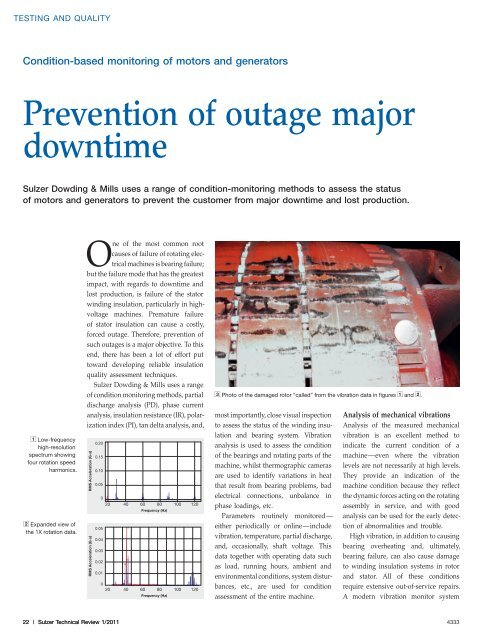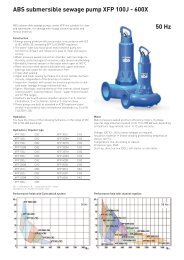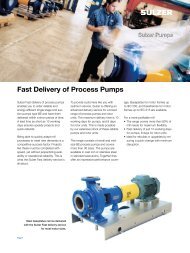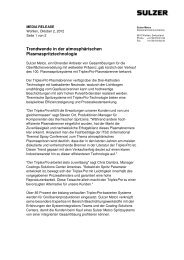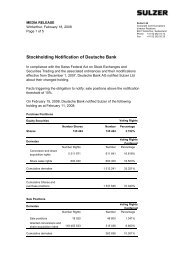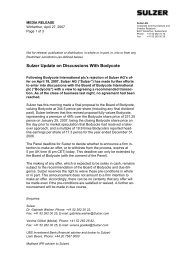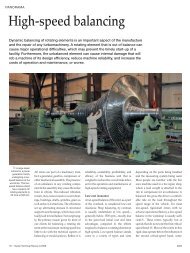Testing and quality
Testing and quality
Testing and quality
You also want an ePaper? Increase the reach of your titles
YUMPU automatically turns print PDFs into web optimized ePapers that Google loves.
TESTING AND QUALITY<br />
Condition-based monitoring of motors <strong>and</strong> generators<br />
Prevention of outage major<br />
downtime<br />
Sulzer Dowding & Mills uses a range of condition-monitoring methods to assess the status<br />
of motors <strong>and</strong> generators to prevent the customer from major downtime <strong>and</strong> lost production.<br />
1 Low-frequency<br />
high-resolution<br />
spectrum showing<br />
four rotation speed<br />
harmonics.<br />
2 Exp<strong>and</strong>ed view of<br />
the 1X rotation data.<br />
22 | Sulzer Technical Review 1/2011<br />
One of the most common root<br />
causes of failure of rotating electrical<br />
machines is bearing failure;<br />
but the failure mode that has the greatest<br />
impact, with regards to downtime <strong>and</strong><br />
lost production, is failure of the stator<br />
winding insulation, particularly in highvoltage<br />
machines. Premature failure<br />
of stator insulation can cause a costly,<br />
forced outage. Therefore, prevention of<br />
such outages is a major objective. To this<br />
end, there has been a lot of effort put<br />
toward developing reliable insulation<br />
<strong>quality</strong> assessment techniques.<br />
Sulzer Dowding & Mills uses a range<br />
of condition monitoring methods, partial<br />
discharge analysis (PD), phase current<br />
analysis, insulation resistance (IR), polarization<br />
index (PI), tan delta analysis, <strong>and</strong>,<br />
RMS Acceleration (G-s)<br />
RMS Acceleration (G-s)<br />
0.20<br />
0.15<br />
0.10<br />
0.05<br />
0.05<br />
0.04<br />
0.03<br />
0.02<br />
0.01<br />
0<br />
20 40 60 80 100 120<br />
Frequency (Hz)<br />
0<br />
20 40 60 80 100 120<br />
Frequency (Hz)<br />
3 Photo of the damaged rotor “called” from the vibration data in figures 1 <strong>and</strong> 2.<br />
most importantly, close visual inspection<br />
to assess the status of the winding insulation<br />
<strong>and</strong> bearing system. Vibration<br />
analysis is used to assess the condition<br />
of the bearings <strong>and</strong> rotating parts of the<br />
machine, whilst thermographic cameras<br />
are used to identify variations in heat<br />
that result from bearing problems, bad<br />
electrical connections, unbalance in<br />
phase loadings, etc.<br />
Parameters routinely monitored—<br />
either periodically or online—include<br />
vibration, temperature, partial discharge,<br />
<strong>and</strong>, occasionally, shaft voltage. This<br />
data together with operating data such<br />
as load, running hours, ambient <strong>and</strong><br />
environmental conditions, system disturbances,<br />
etc., are used for condition<br />
assessment of the entire machine.<br />
Analysis of mechanical vibrations<br />
Analysis of the measured mechanical<br />
vibration is an excellent method to<br />
indicate the current condition of a<br />
machine—even where the vibration<br />
levels are not necessarily at high levels.<br />
They provide an indication of the<br />
machine condition because they reflect<br />
the dynamic forces acting on the rotating<br />
assembly in service, <strong>and</strong> with good<br />
analysis can be used for the early detection<br />
of abnormalities <strong>and</strong> trouble.<br />
High vibration, in addition to causing<br />
bearing overheating <strong>and</strong>, ultimately,<br />
bearing failure, can also cause damage<br />
to winding insulation systems in rotor<br />
<strong>and</strong> stator. All of these conditions<br />
require extensive out-of-service repairs.<br />
A modern vibration monitor system<br />
4333


